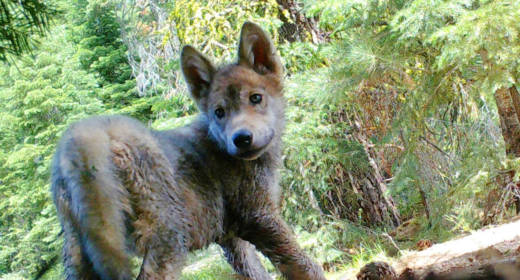California Wolves
In California, state biologists say six wolves with radio tracking collars now rove the sparsely populated corners of Lassen and Plumas counties. Other, uncollared wolves have wandered as far south as Nevada County .
The state’s wolf management plan estimates that Northern California, not including the Sierra, a habitat conducive to the species, could support up to 500 wolves.
California didn’t have any wolves to protect between 1924, when the last wild gray wolf was killed, and 2011, when a lone wolf from Oregon entered Siskiyou County in search of new territory.
Biologists designated the male OR-7. Endangered species activists called him “Journey.” His fans even set up a Twitter account for him.
In California, he found a mate, sired five pups and became the leader of a pack before migrating back to Oregon and fathering even more offspring. The battery in his GPS collar died in 2015, but Oregon biologists have tracked his activity since then.
Last month, the Sacramento Bee reported that an entire California-born pack mysteriously went missing in remote Siskiyou County late last year. Wildlife biologists weren’t able to trap and collar the parent wolves or their five pups before they disappeared.
The California Department of Fish and Wildlife is also investigating the death of a collared yearling male from Oregon.
In 2014, the California Fish and Game Commission granted the gray wolf protection under the state’s Endangered Species Act. That action became the subject of a lawsuit by the Pacific Legal Foundation, the California Farm Bureau Federation and the California Cattlemen’s Association. The groups argued that an unchecked population of wolves would kill deer and valuable cattle.
In January, a San Diego judge ruled against the farmers and ranchers and found even wolves wandering in from neighboring states should be protected by California’s laws.
“They do not need to have been born here,” said Amaroq Weiss, a wolf specialist with the Center for Biological Diversity, which supported the state’s argument that wolves should retain protections. “If they’re coming from the Oregon side of the border or from Nevada, once they set a paw down in California they are protected.”
Weiss says it’s a “miracle” that wolves are coming back to California and thriving. She credits the federal protections they received under federal law.
“Protections are what is necessary to allow a species to get a foothold once again. So having wolves back in California is a success story for the federal Endangered Species Act.”
Some farmers and ranchers see the saga of the U.S. gray wolf in the same way, while coming to a very different conclusion. In a statement, the American Farm Bureau Federation said delisting the wolf from the endangered species list is “a triumph of common sense we all should herald as a conservation success story.”
The group’s president, Zippy Duvall, said, “Populations have far surpassed the recovery thresholds set forth by recovery plans, but too many environmentalists fail to recognize this success.”

